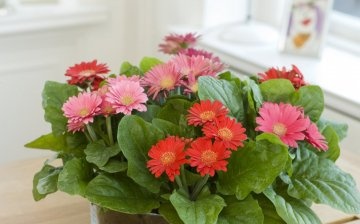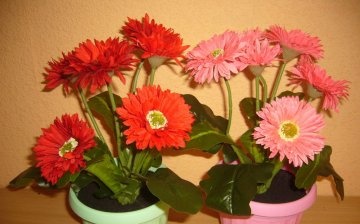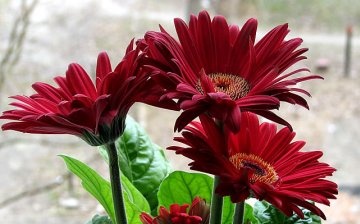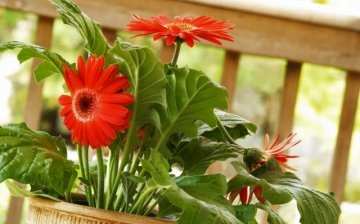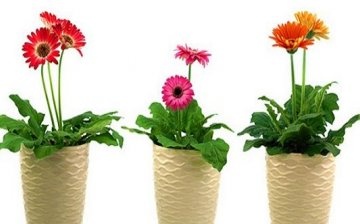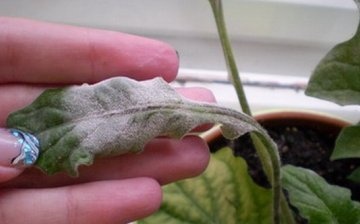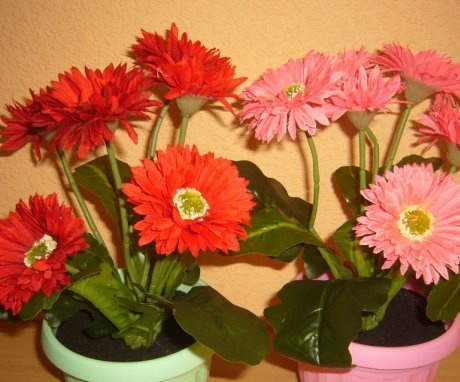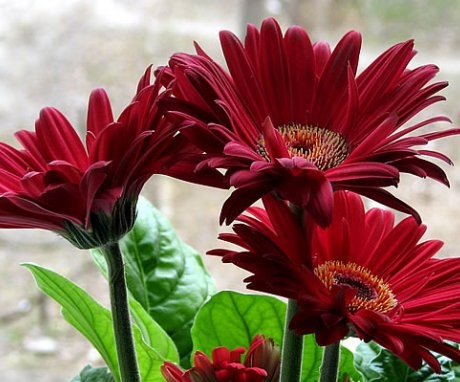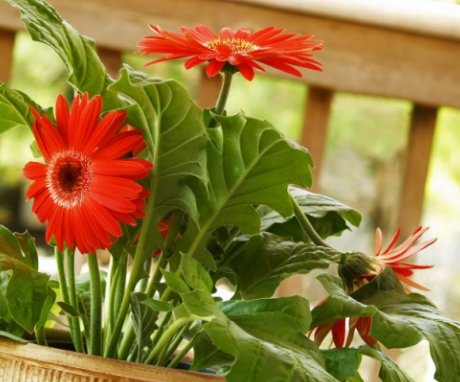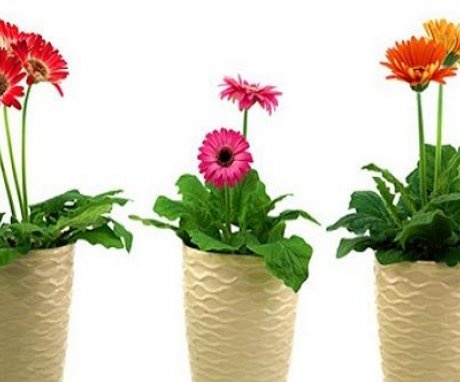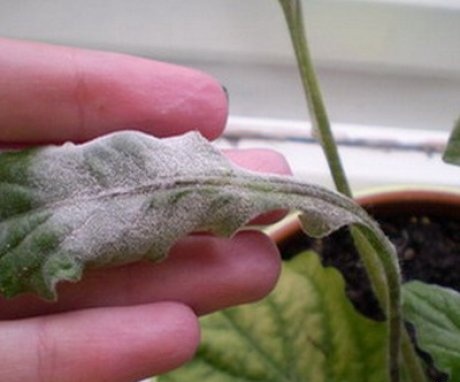Tips for flower growers: how to care for a gerbera
The first gerberas were described by the Dutch botanist Jan Gronovius in the eighteenth century and were named after his best friend, a botanist who worked in Russia. But they began to grow flowers only towards the end of the nineteenth century and the plants became a worthy decoration of the garden.
The first gerberas were grown in the garden of the French breeder R. Jameson in the Transvaal province, after which the flowers are called the Transvaal chamomile. Over time, the labors of breeders have bred many species and varieties of plants that have conquered all countries of the world. Today gerberas are cultivated as decorative flowers for cutting and sale, they decorate gardens, and more recently, Transvaal daisies are gaining popularity in indoor floriculture.
Content
- What indoor gerberas look like
- How to create optimal growing conditions
- Plant care rules
- How to transplant and propagate gerberas
- Protection against diseases and pests
What indoor gerberas look like
Gerberas (Gerbera) began their distribution from African countries, therefore, they have a positive attitude towards the tropical and subtropical climate. The flower belongs to the genus "Astrovye" or "Compositae" and according to the external data of the inflorescences it resembles a sunflower or chamomile, and some varieties, with semi-double flowers, look like asters.
Gerberas - These are perennial showy flowers with large inflorescences, which can have various shades, except for blue, pale yellow or coal-black cores. Elongated, dissected leaves with pointed tips are represented by a rosette and grow up to 37 cm. Some varieties are characterized by pubescence of the bases of leaves and petioles. Garden gerberas bloom with inflorescences-baskets, placed on high peduncles, over half a meter. As for indoor plants, their height does not exceed 35 cm.
The plant pleases with beautiful flowering in spring, summer and autumn, which ends in the formation of seeds.
The genus of Transvaal chamomile includes about eighty plant varieties, which differ in size, color and flower shape. Most varieties are represented by hybrid forms, which were bred by crossing two natural varieties - Jameson's gerberas and green-leaved ones. The flowers of miniature pot cultivars are spread from Holland.
It should be noted that domestic gerberas do not live long, and after the third or fourth period of flowering, the number of flowers decreases and the plant loses its decorative effect. Therefore, transvaal daisies need rejuvenation, that is, replacing an old plant, but a young one.
For cultivation in indoor conditions, Jameson's gerbera and its hybrids are suitable:
- Gerbera Parade with sunny and carrot tones and cores of the same color.
- Gerbera Happipot with pink flowers formed by multi-layered petals. The cores are usually brown, framed by small petals.
- Gerbera Ilios comes in a variety of flower shapes and sizes and comes in orange, yellow and light red shades.
- Gerbera Hummingbird is a plant with rich green leaves and bright sunny, burgundy and scarlet flowers.
Not every grower dares to grow gerberas at home, believing that this process is rather complicated and troublesome. But if you create favorable conditions for the plant and proper care, then the African guest will dilute the interior with a colorful landscape.
How to create optimal growing conditions
In creating optimal conditions for successful development and flowering, the plant has special requirements for lighting, temperature and humidity levels:
- Lighting. Gerbera blooms directly depend on the amount of sunlight, but direct sunlight can harm the delicate tissues of the plant. To form fully developed buds, the plant needs to provide the correct light regime, which should not exceed 12 hours a day. This feature explains the fact that gerberas actively bloom in the spring and autumn, and actively overgrow with green mass in summer. But if in the summertime the flower is moved to the darkened part of the house, then it will delight with flowers. You can also achieve flowering in winter, providing additional artificial lighting... But experienced florists are advised to give the plant a rest.
- Temperature conditions. An equally important condition for abundant flowering. Given that the gerbera is a native of Africa, the optimal temperature for its development will be 20-24 degrees. It should also be remembered that the plant is painfully tolerant of low temperatures. During the rest period, the temperature threshold should not fall below 12-15 degrees Celsius, and during the flowering season - below 23 degrees.
- Humidity level. Gerberas do not have special requirements for air humidity, but they will not mind spraying in hot weather. Excess moisture during sleep can lead to the development of diseases... Therefore, it is necessary to spray the plants if they are placed close to the heating device.
Plant care rules
Having provided competent care, consisting of simple rules, you can admire gerbera flowers several times a year. Observe irrigation regimes. Transvaal chamomile needs regular but moderate watering. The earthen lump must have time to dry out between procedures in order to prevent stagnation of water in the near-root zone.
The best option would be irrigation, by pouring water into the sump and draining the excess.
For irrigation, you need to use settled, not cold water. When the plant is resting, watering is minimized, and the regime is restored in the spring when the plant awakens.
Provide additional food. Gerberas need to be fed very carefully. Organic matter should be excluded, because the flower does not perceive it well. And feeding should be carried out according to the scheme:
- during active foliage growth after awakening, nitrogen compounds should prevail in the dressing. After a set of green mass, fertilizers need to be changed to potash
- feed plants with complex mineral fertilizers for blooming indoor flowers
- fertilizers are applied at intervals of one month
Inexperienced growers often think that if gerberas are watered and fed more often, they will begin to bloom earlier. But practice shows that this approach provokes the development of diseases.
How to transplant and propagate gerberas
The transplant of indoor gerberas is carried out in case of emergency: if the root system has grown and went beyond the container, with decay and root diseases. The procedure is carried out according to certain rules:
- manipulation is carried out in early spring
- use the method of transshipment while preserving an earthen clod so as not to damage the delicate and fragile roots
- the size of the planting container should not exceed a diameter of 25 cm and a depth of 30 cm
- the substrate should consist of two parts of leafy soil, one part of peat and one part of sand
If transplanting is carried out after purchase, then you need to give the plant time to adapt for several weeks. When purchasing gerberas, you need to remember that every three to four years the plant needs to be rejuvenated.
For reproduction, seed, cuttings and root division are used:
- Seed method. With the arrival of spring, the seed is placed in prepared soil, sprinkled with sand, moistened and covered with film or sand. In warm conditions with good lighting sprouts will hatch in a week. After that, the shelter is removed, and when 2-3 full-fledged leaves grow, the plants are seated. They quickly start to grow and begin to bloom in the same year.
- Method cuttings... In the process of transplanting, several plots with two growth points can be taken away from the rhizome. The roots and aerial parts are trimmed for children, the cut sites are disinfected. The planting material is planted in separate containers, leaving the neck on the surface.
- Method dividing the bush... Also performed during the transplant. Root system carefully divided into several parts, preserving the aerial parts, which have at least two leaves. Planting material is planted in separate containers with prepared soil and placed in a warm, well-lit place.
Protection against diseases and pests
Domestic gerberas are not picky, but under unfavorable conditions they can be adversely affected by some diseases and pests:
- gray rot and powdery mildew, if waterlogging and lack of air are allowed
- late blight and fusarium - due to violations of temperature and lighting
- whiteflies, spider mites and aphids - at elevated temperatures, too dry air and insufficient irrigation
If diseases or pests nevertheless hit the gerbera, then it must be separated from other green inhabitants, all affected areas should be removed and the necessary treatments carried out: to destroy insects - with systemic insecticides, and in case of diseases - fungicides.
Preventive measures are the observance of all the rules of care, regular examinations and steaming the soil in order to disinfect.
When caring for gerberas, you should listen to the advice of experienced florists. This will help you get healthy, flowering plants that will easily grow and decorate your home or office with bright, fragrant flowers. Transvaal chamomiles do not require special attention, it is enough to create optimal conditions for their successful growth once, to carry out timely irrigation, fertilizing and transplanting as needed.
More information can be found in the video:



